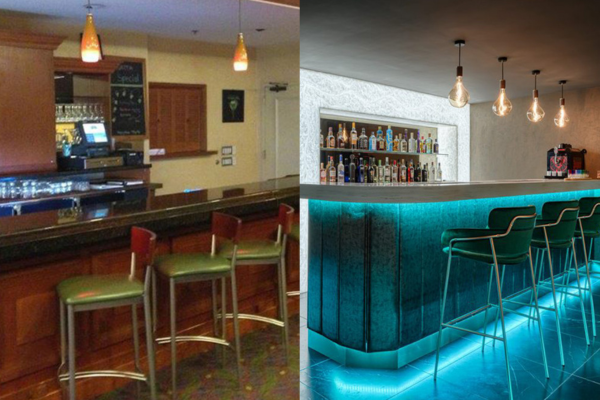“The details are not the details. They make the design.”
Charles Eames
In the competitive world of the restaurant industry, creating a memorable dining experience is vital for attracting and retaining customers. A significant aspect of achieving this lies in the interior design of the restaurant. The ambiance, aesthetics, and overall atmosphere play a pivotal role in shaping diners’ perceptions and influencing their decision to return. In this blog, we will delve into the enchanting world of before and after in hospitality interior deisgn, exploring how innovative design changes can turn an ordinary eatery into an extraordinary culinary haven.
The Before: A Blank Canvas
Before embarking on a transformation journey, restaurants and modern coffee shop often find themselves faced with a blank canvas – a space that lacks character and allure. Dull walls, uninspiring furnishings, and unimaginative layouts are common culprits that stifle the potential for an unforgettable dining experience.
While some establishments may have had their heyday, their interior design may now seem outdated, out of sync with contemporary trends, or no longer appealing to their target audience. It can be hard for guests to connect with the space and feel at ease without any current design element that would highlight the restaurant’s brand or personality.
The layout of the restaurant may make it hard for guests to reach their seats, and thus they may not be able to get in. Poor acoustics can make it difficult for guests to talk to each other and enjoy their meals in a blank canvas restaurant. Restaurant operators can turn a blank surface into thriving establishments, both visually appealing and functioning, by carefully addressing these challenges.
The After: A Feast for the Senses
Here are the steps we will take for the interior transformations for restaurant
1. Elevating Ambiance: Lighting and Colour
The transformative power of lighting and colour cannot be overstated. Restaurants often opt for warm and inviting lighting, creating a cosy and intimate ambience for diners. Strategic use of vibrant or calming colours can also influence guests’ moods, setting the stage for a delightful culinary journey. Warm lighting is commonly associated with comfort and relaxation, making it a trendy choice for restaurants. It is possible to create it with a warm colour temperature of around 2700K in incandescent, halogen or LED bulbs.
Excellent lighting, which is often associated with energy and excitement, is a good choice for more casual or fast-food restaurants. Fluorescent or LED light bulbs with a cold colour temperature range of around 4000 K can be used to create it. Specific spaces such as tables, bars or buffet areas will be illuminated by task lighting. In order to highlight particular features of the restaurant, such as artwork, architecture or displays, accent lighting is used.
Energy, excitement, and appetite are associated with warm colours such as red, orange, and yellow. Relax, calm, and balance are associated with cool colours such as blue, green, and purple. Neutral colours can be used to create a variety of atmospheres, such as white, cream, or beige. Restaurants can create an inviting, welcoming atmosphere that enhances their diners’ dining experience by strategically integrating lighting and colour.
2. Reimagined Layouts
A well-thought-out restaurant layout can significantly impact the dining experience. From open-concept design that encourages socialising to intimate nooks for romantic dinners, the proper layout can cater to diverse customer preferences. In restaurants, where the guests are allowed to see what is being made and interact with chefs, concept kitchens continue to gain popularity.
A more lively and pleasant atmosphere is created by the shared seating, which encourages socialisation and interaction between guests. The restaurant is also using its space more creatively to create multifunctional spaces that can be used for different purposes; for instance, private events or meals during off-peak times may take place in the bar area.
About the seating arrangements, restaurants are also becoming more flexible. To allow guests to select the cuisine, some restaurants offer movable tables and chairs. Other establishments provide a wide range of seating options, including booths, tables and stands, to accommodate various size groups and preferences.
Maximising seating capacity without compromising comfort is an art form in which restaurant designers excel. Restaurant interior designers may develop designs that are both inviting and functional through careful consideration of these factors.
3. Thematic Decor
Injecting a unique theme into the restaurant’s interior can add a touch of magic that captivates diners. Whether it’s an exotic tropical paradise, a rustic countryside charm, or an avant-garde futuristic setting, themed décor can transport guests to another world. A few cases of restaurants that use Themed décors to attract guests from other worlds are:
1) The Rainforest Cafe is a popular chain restaurant that transports guests to a tropical rainforest. There are lovely gardens, exotic species and waterfalls in the restaurant
2) The Alice in Wonderland Restaurant in Tokyo is a whimsical restaurant that recreates the world of Alice’s Adventures in Wonderland
3) The Ninja New York is a unique restaurant that transports guests to a world of ninjas.
There are dark, mysterious décor and entertainment with ninja themes in the restaurant. To create a themed restaurant, it is appropriate to consider some factors, as the theme should apply to all areas of the restaurant, such as its décor, menus and uniforms.
There must be a theme which is real and convincing. This experience should surprise and delight guests. Considering these factors will allow restaurateurs to develop Themed Restaurants, which are both visual and interactive.
4. Artistic Approaches
Artworks, murals, and sculptures provide a sense of sophistication and visual appeal to the dining space. They also offer an opportunity for the restaurant to showcase local talent and connect with the community. The artwork should complement the whole restaurant’s style.
For example, abstract paintings or sculptures may be present in a modern restaurant, whilst traditional restaurants might have landscapes and portraits. The size of an art piece should be appropriate for the area so that a big painting can fit in a nice dining room, whereas it’s better to take up less space.
The painting must be positioned in a way which complements the restaurant’s look and does not interfere with guests’ views. A large painting can be mounted over a fireplace or on an empty wall, as an example.
To improve the atmosphere and create a truly unique and memorable dining experience for your guests, you will be able to select works of art by carefully considering these factors.
5. Embracing Sustainability
With an increasing stress on sustainability, many restaurants integrate eco-friendly elements into their interior designs. From reclaimed wood furniture to energy-efficient lighting, these choices not only contribute to environmental preservation but also resonate with environmentally-conscious patrons. To add a rural and distinctive touch to every restaurant’s interior, recycled wood furniture is an environmentally sound choice.
It’s intended to construct tables, chairs, benches and other furniture pieces. Using energy-efficient lighting can help restaurants reduce their energy consumption and save money on their energy bills. LED lighting is a popular choice for efficient lighting due to its durability and the fact that it uses less energy than traditional incandescent bulbs.
As they emit less volatile organic compounds, Low VOC paints are a healthier choice for both guests and staff. Health problems such as headache, irritation of the eyes and breathing difficulties may be caused by VOCs. In a restaurant, living plants may purify the air and make it more inviting and relaxing.
Plants can be planted in containers on tables or kitchens and hung from ceilings. Restaurants could create a more sustainable and environment-friendly dining experience for their guests by taking these steps.
6. Integrating Technology
Incorporating technology into the restaurant’s interior design can enhance the dining experience. Digital menus, interactive tabletops, and immersive audiovisual installations can elevate the guest’s engagement and create a lasting impression.
To facilitate guest access to food, the ordering and payment process can be simplified by digital menus, online orders or self-serve kiosks. Interactive tabletops and immersive audiovisual installations can provide guests entertainment and information, making the dining experience more memorable.
Tablet-based point-of-sale (POS) and kitchen display systems (KDS) can improve communication between staff and streamline operations, leading to better service for guests. At restaurants, robotic servers are becoming more and more popular.
It can be used for deliveries to tables, taking orders or even simple dishes and will have a benefit in terms of reducing the cost of labour and improving efficiency. In general, technology integration may be a valuable tool for enhancing the dining experience and creating more distinctive restaurant concepts.
Results
A successful interior transformations can bring significant advantages to restaurant. Improved aesthetics and ambience can attract new customers and entice existing ones to return for another visit. The positive impact of the impressive transformation can lead to word-of-mouth marketing, resulting in increased foot traffic and favourable online reviews.
Additionally, by aligning with contemporary design trends and catering to modern preferences, restaurants can capture the attention of younger demographics and establish themselves as chic cafe design space.
Before and after interior transformations in the restaurant sector represent a captivating journey of reinvention and creativity. From a blank canvas to a feast for the senses, the process involves challenges and rewards. By embracing innovation, thematic storytelling, and sustainability, restaurants can revitalise their identities and provide guests with unforgettable dining experiences.
The magic of interior transformations in the restaurant sector extends beyond aesthetics; it is a celebration of the culinary arts and a testament to the power of design in shaping our perceptions and emotions. Oraanj Interior Design brings this magic to life, creating spaces that not only look stunning but also enhance the overall dining experience.
Author: Gunjan Khemka & Sagar Kuchhadia (Interior Designer)





